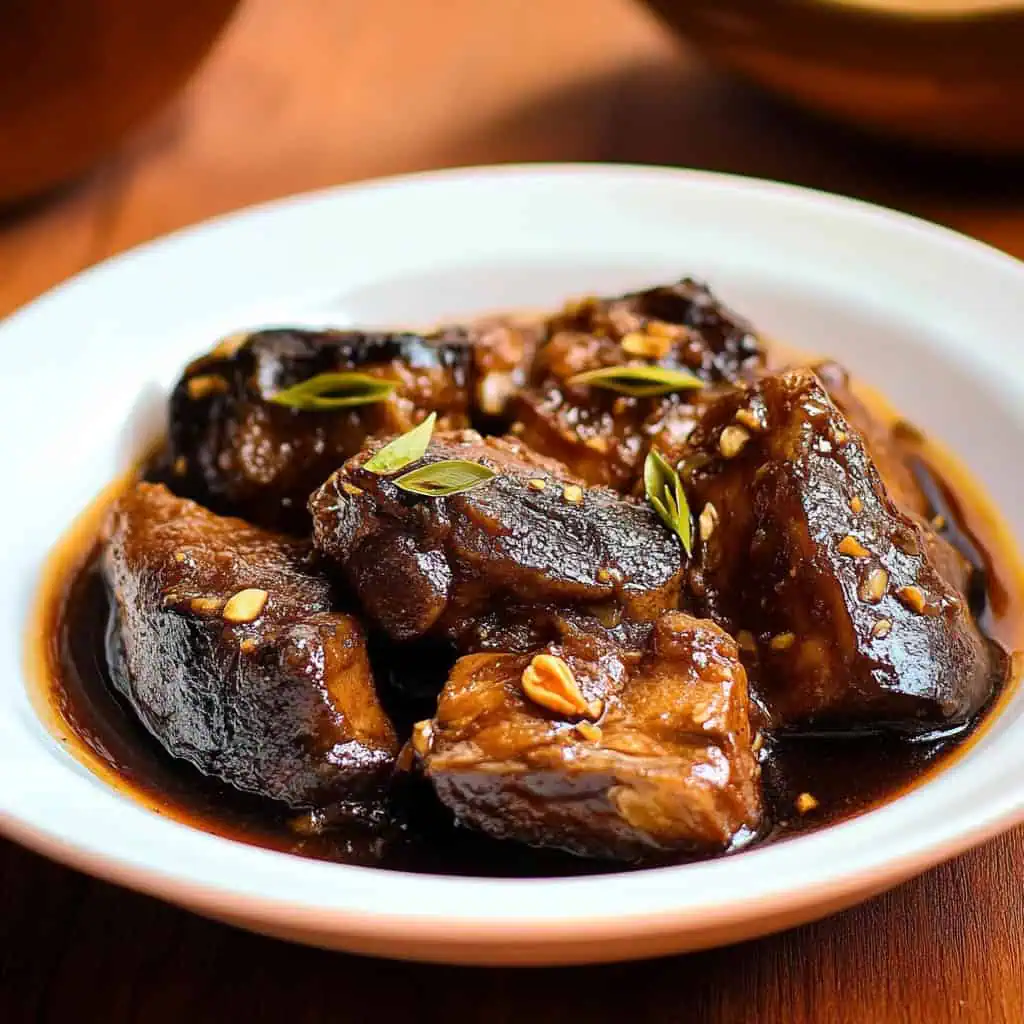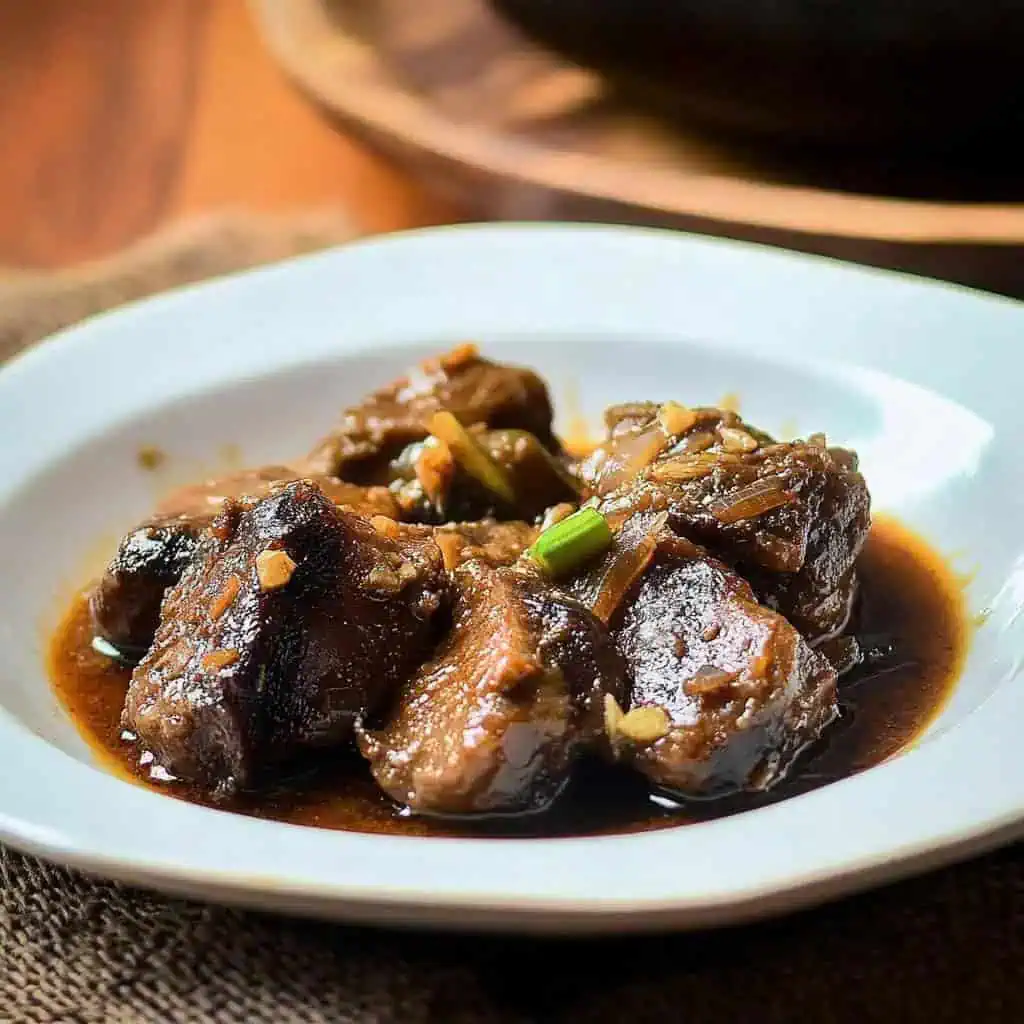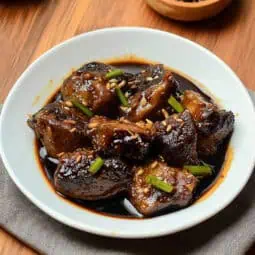Living in our small town of Pilar, Bataan, my Uncle Rolando would often surprise us with freshly caught hito (catfish) from the nearby palaisdaan (fishpond) early in the morning.
The sight of him walking through our gate, holding up his prized catch with a proud smile, meant we were in for a treat: his famous Adobong Hito.
This recipe brings back memories of gathering around our wooden dining table, the intoxicating aroma of vinegar and garlic filling our humble kitchen as the fish simmered in its rich, dark sauce. While most Filipinos know adobo as a pork or chicken dish, this catfish version holds a special place in my heart, and like most local families, we've perfected our own way of cooking it through generations.
Today, even though I can't get freshly caught hito from Uncle Rolando anymore, I still make this dish regularly for my own family.
The beauty of Adobong Hito lies in its simplicity: crispy fried catfish transformed by the bold flavors of vinegar, soy sauce, and aromatics into something truly extraordinary.
Jump to:

Why You'll Love This Recipe
- Restaurant-Quality Results: Learn the secrets to achieving that perfect balance of crispy exterior and tender, flaky fish
- Budget-Friendly: Catfish is an economical protein option that doesn't compromise on flavor
- Authentic Technique: Traditional methods passed down through generations
- Versatile: Can be served for family dinner or as pulutan (beer snacks)
- Make-Ahead Friendly: Tastes even better the next day
Ingredients
The ingredients in Adobong Hito create a perfect balance of flavors that complement catfish beautifully. The vinegar and calamansi cut through the natural richness of the fish while helping remove any muddy taste. Soy sauce adds deep umami notes that enhance the catfish's natural flavors.
Aromatics like garlic, onion, and ginger create a flavorful base while also neutralizing any fishy odors. The addition of star anise and bay leaves brings subtle warmth and complexity, while brown sugar balances the tanginess of the vinegar. Tomatoes add a natural sweetness and slight acidity that rounds out the sauce.
Together, these ingredients transform an ordinary catfish into an extraordinary dish with layers of flavor that become even more delicious as they meld together during cooking.

For the Fish:
- 1 whole catfish (about 2 pounds), cleaned and gutted
- ¼ cup rock salt
- 5 calamansi, halved
- Canola oil for frying
For the Adobo Sauce:
- ¼ cup soy sauce
- ¼ cup white vinegar
- 4 cloves garlic, minced
- 1 medium onion, thinly sliced
- 1 thumb-sized ginger, julienned
- 1 large Roma tomato, chopped
- ½ cup water
- 1 tablespoon brown sugar
- 2 bay leaves
- 1 whole star anise
- ¼ teaspoon whole peppercorns
For Garnish:
- Fried garlic bits
- Green onions, chopped
Equipment
- Large Wok or Deep Pan: Essential for frying the fish and preparing the sauce. The curved shape allows for even heat distribution and easy tossing.
- Kitchen Tongs: For safely handling the fish while frying and turning it without breaking the delicate flesh.
- Sharp Knife: Necessary for cleaning and cutting the fish into proper portions.
- Wooden Spoon: Perfect for gentle stirring without breaking the fish pieces during simmering.
- Strainer: Used for draining excess oil after frying the catfish.
- Heavy-bottomed Pot: Ideal for simmering the adobo sauce as it retains heat evenly.
- Cutting Board: Preferably with a juice groove to contain liquids when cleaning and cutting the fish.
- Paper Towels: For draining the fried catfish and removing excess oil.
- Measuring Cups and Spoons: For precise ingredient measurements to achieve balanced flavors.

How To Make
- Begin by thoroughly cleaning the catfish. Rub the fish with rock salt to remove the slime and let it sit for 5 minutes. Using a dull knife, scrape the fish gently, then rinse with calamansi juice. Perform a final salt rub and rinse with water. Cut the cleaned fish into 2-inch sections and combine with soy sauce, peppercorns, and half of the minced garlic. Allow to marinate in the refrigerator at 40°F (4°C) for 10-15 minutes.
- While the fish marinates, prepare your aromatics by mincing the garlic, thinly slicing the onions, julienning the ginger, and chopping the tomatoes. Have all your sauce ingredients measured and ready.
- Heat canola oil in a large wok or deep pan to 350°F (175°C). Carefully fry the marinated fish sections until they achieve a golden brown color, approximately 5-7 minutes. Remove the fried fish and drain on paper towels to remove excess oil. Keep the oil hot but reduce to medium heat.
- In the same pan, sauté the remaining garlic, onions, and ginger until fragrant at medium heat (350°F/175°C). Add the chopped tomatoes and cook until they become soft. Pour in the vinegar and bring to a boil for 2 minutes without stirring. Add the soy sauce, water, brown sugar, bay leaves, star anise, and whole peppercorns.
- Once the sauce is simmering, carefully add the fried catfish pieces. Reduce the heat to low (300°F/150°C) and let it simmer for 15 minutes, allowing the fish to absorb the flavors while the sauce reduces to your desired consistency. Occasionally spoon the sauce over the fish, being careful not to break the pieces.
- Serve hot, garnished with fried garlic bits and chopped green onions.

Tips from Lola's Kitchen
- Fish Selection: Choose catfish with clear, bright eyes, bright red gills, and firm flesh that springs back when pressed. These are signs of freshness.
- Slime Removal: For an authentic traditional method, use wood ash as an alternative to salt for removing the slime. This old Filipino technique imparts a subtle flavor.
- Frying Technique: Don't overcrowd the pan when frying. Work in batches if necessary to maintain proper oil temperature and ensure even crispiness.
- Sauce Concentration: For a more concentrated flavor, let the sauce reduce longer. For a saucier dish, add a little more water.
- Rest Before Serving: Let the dish rest for 5-10 minutes after cooking to allow the flavors to meld and deepen.
- Oil Selection: While canola oil works well, using coconut oil adds another layer of authentic Filipino flavor.
- Vinegar Tip: After adding vinegar, let it boil for 2 minutes without stirring to cook off the harsh acidity while maintaining its tanginess.
Substitutions
- Fish Alternative: No catfish? Try kanduli, pangasius, or even tilapia. Each will provide a different texture but will work well with the adobo sauce.
- Citrus Options: Replace calamansi with lemon or lime juice at a 1:1 ratio.
- Vinegar Variations: Apple cider vinegar or rice vinegar can substitute for white vinegar, though each brings a slightly different flavor profile.
- Sweetener Options: Coconut sugar or honey can replace brown sugar. Start with slightly less as honey is sweeter.
- Soy Sauce Alternatives: For a gluten-free version, use tamari or coconut aminos (use about 20% less as coconut aminos are sweeter).
- Aromatics Flexibility: No fresh ginger? Use 1 teaspoon of ground ginger. Missing star anise? Add a pinch of Chinese five-spice powder.
Troubleshooting
- Fish Breaking Apart: Ensure the fish is fried properly to create a firmer exterior before adding to the sauce. Also, handle the fish gently with a wooden spoon rather than metal utensils.
- Too Sour: Add sugar gradually, starting with 1 teaspoon and tasting as you go until the desired balance is achieved.
- Too Salty: Add a quartered potato to the sauce while simmering to absorb excess salt, or add a splash more water and a touch of sugar to rebalance.
- Muddy Taste: If your catfish has a strong earthy flavor, soak it in a mixture of 1 cup vinegar to 4 cups water for 30 minutes before cooking, then rinse thoroughly.
- Sauce Too Thin: Simmer uncovered for longer to reduce and concentrate the flavors.
- Sauce Too Thick: Add a tablespoon of water at a time until you reach your desired consistency.
Storage & Reheating
- Refrigeration: Store in an airtight container for up to 3 days. The flavors actually improve overnight as the fish continues to absorb the sauce.
- Freezing: Not recommended for this dish as the texture of the fish will deteriorate when thawed.
- Reheating: Use low heat in a covered pan with the sauce for 10-15 minutes to maintain the fish's texture. Avoid microwave reheating as it can make the fish rubbery.
- Serving Cold: Some people enjoy leftover Adobong Hito cold, straight from the refrigerator, as the flavors concentrate when chilled.
- Sauce Preservation: If you have leftover sauce but no fish, store the sauce separately, it makes an excellent flavoring for other dishes.

FAQ
Why is my catfish falling apart during cooking?
Ensure proper frying before adding to sauce to create a firmer exterior. Handle the fish minimally and gently during the simmering process. Using fresh, firm catfish also helps maintain integrity during cooking.
Can I make this dish ahead for a party?
Yes! The flavors actually improve overnight. Make it a day ahead, store properly in the refrigerator, and gently reheat before serving. This makes it perfect for entertaining.
How do I reduce the fishy smell while cooking?
The ginger in this recipe helps neutralize fishy odors. You can also add a small splash of lime juice to the cooking oil before frying, and ensure your catfish is extremely fresh.
Can I reduce the vinegar for a milder taste?
Yes, you can reduce the vinegar slightly, but maintain at least a 1:1 ratio with soy sauce for authentic adobo flavor. Consider using a milder vinegar like rice vinegar instead of reducing the quantity.
What sides pair best with Adobong Hito?
Traditional pairings include steaming hot white rice, fresh tomato and onion ensalada, green mango slaw (atsarang mangga), and spicy vinegar dipping sauce (suka at sili).
Can I use fillets instead of whole catfish?
Yes, catfish fillets work well and require less preparation time. Reduce the frying time to 3-4 minutes per side and be extra gentle when simmering in the sauce.
Is this recipe suitable for people watching their sodium intake?
You can reduce sodium by using low-sodium soy sauce and cutting the salt used in the cleaning process (just rinse thoroughly afterward). The dish will still have plenty of flavor from the aromatics.
Related
Looking for other recipes like this? Try these:

Adobong Hito (Filipino Catfish Adobo)
Equipment
- Large Wok or Deep Pan (kawali) For frying the fish and preparing the sauce
- Sharp Knife (sipit) For safely handling the fish while frying
- Sharp knife (kutsilyo) For cleaning and cutting the fish
- Wooden spoon (sandok) For gentle stirring without breaking the fish
- Strainer [Salaan] For draining excess oil
- Heavy-bottomed Pot (kaldero) For simmering the adobo sauce
Ingredients
For the Fish:
- 1 whole catfish about 2 pounds, cleaned and gutted (isang buong hito)
- ¼ cup rock salt asin
- 5 calamansi halved
- Canola oil for frying
For the Adobo Sauce:
- ¼ cup soy sauce toyo
- ¼ cup white vinegar suka
- 4 cloves garlic minced (bawang)
- 1 medium onion thinly sliced (sibuyas)
- 1 thumb-sized ginger julienned (luya)
- 1 large Roma tomato chopped (kamatis)
- ½ cup water tubig
- 1 tablespoon brown sugar asukal
- 2 bay leaves dahon ng laurel
- 1 whole star anise sangke
- ¼ teaspoon whole peppercorns paminta
For Garnish:
- Fried garlic bits sinangag na bawang
- Green onions chopped (sibuyas na mura)
Instructions
- Begin by thoroughly cleaning the catfish (paglilinis ng hito). Rub the fish with rock salt (asin) to remove the slime and let it sit for 5 minutes. Using a dull knife, scrape the fish gently, then rinse with calamansi juice. Perform a final salt rub and rinse with water. Cut the cleaned fish into 2-inch sections and combine with soy sauce (toyo), peppercorns (paminta), and half of the minced garlic (bawang). Allow to marinate in the refrigerator at 40°F (4°C) for 10-15 minutes.
- While the fish marinates, prepare your aromatics by mincing the garlic, thinly slicing the onions (sibuyas), julienning the ginger (luya), and chopping the tomatoes (kamatis). Have all your sauce ingredients measured and ready.
- Heat canola oil in a large wok or deep pan (kawali) to 350°F (175°C). Carefully fry the marinated fish sections until they achieve a golden brown color, approximately 5-7 minutes. Remove the fried fish and drain on paper towels to remove excess oil. Keep the oil hot but reduce to medium heat.
- In the same pan, sauté the remaining garlic, onions, and ginger until fragrant at medium heat (350°F/175°C). Add the chopped tomatoes and cook until they become soft. Pour in the vinegar (suka) and bring to a boil for 2 minutes without stirring. Add the soy sauce, water (tubig), brown sugar (asukal), bay leaves (dahon ng laurel), star anise, and whole peppercorns.
- Once the sauce is simmering, carefully add the fried catfish pieces. Reduce the heat to low (300°F/150°C) and let it simmer for 15 minutes, allowing the fish to absorb the flavors while the sauce reduces to your desired consistency. Occasionally spoon the sauce over the fish, being careful not to break the pieces.
- Serve hot, garnished with fried garlic bits and chopped green onions. This dish can be stored in an airtight container in the refrigerator for up to 3 days. When reheating, use low heat in a pan with the sauce for 10-15 minutes to maintain the fish's texture.
Tips from Lola's Kitchen
- Fish Selection: Look for clear, bright eyes and red gills
- Slime Removal: Use wood ash (abo) as a traditional alternative to salt
- Frying Technique: Don't overcrowd the pan to maintain oil temperature
- Sauce Balance: Taste before adding sugar - adjust based on vinegar's acidity
Nutrition
The Story Behind Adobong Hito (Filipino Catfish Adobo)
In the heart of rural Philippines, where fish ponds (palaisdaan) dot the countryside, Adobong Hito emerged as a testament to Filipino ingenuity in cooking. This dish represents the perfect marriage between the abundance of freshwater catfish in local waters and the Philippines' most famous cooking method - adobo. While pork and chicken adobo might be more internationally recognized, this fish version holds its own special place in Filipino cuisine, particularly in regions where catfish farming thrives, such as Pampanga, Bulacan, and Pangasinan.
The origin of Adobong Hito can be traced to practical roots. Filipino farmers and fishermen needed ways to preserve their catch in the tropical heat, and the vinegar-based adobo method proved perfect. The combination of vinegar and soy sauce not only preserved the fish but also eliminated any muddy taste that catfish sometimes carries. This preservation technique evolved into a beloved cooking style that transforms humble catfish into a dish worthy of any Filipino celebration.
What makes this dish particularly special is how it showcases the Filipino palate's love for bold, tangy flavors. Unlike other adobo variations, Adobong Hito incorporates ginger, which not only adds warmth to the dish but also helps neutralize the fishy smell. Local cooks often add tomatoes, a practice that became popular in central Luzon, adding a subtle sweetness that balances the sharp notes of vinegar and soy sauce.
Today, Adobong Hito remains a staple in Filipino households, especially during the rainy season when catfish are most abundant. It's a dish that tells the story of Philippine cuisine - resourceful, flavorful, and deeply connected to the land and waters that sustain its people. Whether served in humble carinderias (local eateries) or prepared for special family gatherings, this dish continues to capture the essence of Filipino home cooking.










Comments
No Comments